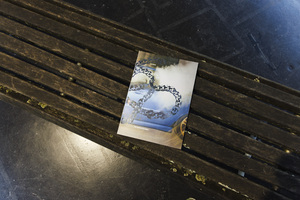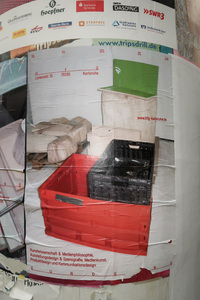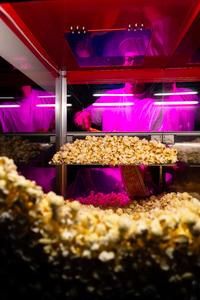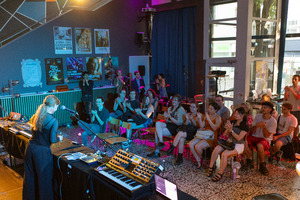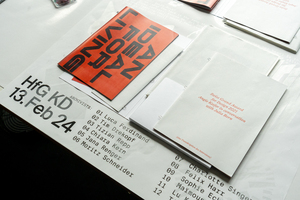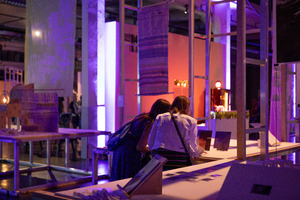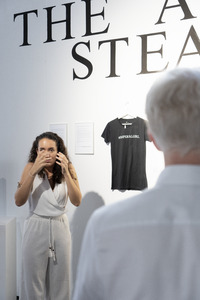Rundgang 2024 - Preisverleihung
Benachbarte Sets (15)Alle Zusammenhänge anzeigen
Diese Sets wurden den gleichen Sets hinzugefügt wie das ausgewählte Set.
15 Inhalte
- Seite 1 von 2
Stadt als Sammlung
- Titel
- Stadt als Sammlung
- Autor/in
- Beschreibung (de)
- Das Projekt „Stadt als Sammlung“ ist ein interdisziplinäres Forschungsprojekt, das sich mit den Herausforderungen und Potenzialen des analogen und digitalen Archivierens und Sammelns auseinandersetzt.
- Beschreibung (en)
- The project "Stadt als Sammlung" is an interdisciplinary research project that deals with the challenges and potentials of analog and digital archiving and collecting.
- Kategorie
- Schlagworte
- Mitwirkende
- Ort: Institution
- Ort
- 1. OG, mittlere Lichtbrücke
- Titel
- Stadt als Sammlung
- Projektleiter/in
- Semester
- Studiengang
- Typ der Abschlussarbeit
- Importiert am
- 07.08.2024
- Übergeordnete Sets
- 0
- Set enthält
- 1 5
Rundgang-Tagesüber-2024
- Titel
- Rundgang-Tagesüber-2024
- Titel (en)
- Tour-day-2024
- Kategorie
- Datierung
- 18.07.2024
- Ort: Institution
- Ort
- Lichthof
- Stadt
- Land
- Auftrag durch
- Presse HFG
- Titel
- Rundgang-Tagesüber-2024
- Studiengang
- Importiert am
- 22.07.2024
- Übergeordnete Sets
- 1
- Set enthält
- 0 21
Rundgang 2024
- Titel
- Rundgang 2024
- Untertitel
- Ausstellung und Performances mit Führungen zu rund 100 studentischen Arbeiten
- Beschreibung (de)
- Vom 18. bis 21. Juli 2024 öffnet die Staatliche Hochschule für Gestaltung (HfG) Karlsruhe wieder ihre Türen für ihre große Jahresausstellung mit Arbeiten aller Fachgruppen und aus allen Studienjahren. Der Rundgang durch die Lichthöfe zeigt zum Ende des Sommersemesters rund 100 studentische Arbeiten und Performances aus den Studiengängen Ausstellungsdesign & Szenografie, Kommunikationsdesign, Kunstwissenschaft & Medienphilosophie, Medienkunst sowie Produktdesign.
Der viertägige Rundgang ist ab der Eröffnung am 18.07.2024 mit täglich wechselnden Programmpunkten aus Führungen, Lesungen, Performances, Filmvorführungen, Workshops und Events bis zum 21. Juli 2024 zu erleben. Das Begleitprogramm und zwei weitere Ausstellungen in Kooperation der HfG mit den Hallenbaunachbarn ZKM und Städtische Galerie zeigen Ihnen die Vielseitigkeit des Studiums und den gestalterischen Anspruch der HfG auf internationalem Niveau.
Das diesjährige Ausstellungsdesign wurde von Studierenden der HfG unter Leitung von Gastprofessorin Doris Dziersk erarbeitet.
Der Rundgang wird am 18. Juli um 18.00 Uhr feierlich eröffnet durch eine Begrüßung und Empfang mit Constanze Fischbeck (HfG), Helga Huskamp (ZKM), Stefanie Patruno (Städtische Galerie), Henning Rickmann (Fördergesellschaft) und den Ausstellungsteams des Rundgangs.
PROGRAMM ZUM RUNDGANG 2024
Donnerstag, 18.07.
16:00 Uhr Soft Opening der gemeinsamen Ausstellung von HfG und ZKM „Antennae: Frequenzen aus dem Archiv“ im ZKM
16:00 Uhr Soft Opening der an der HfG erarbeiteten Studio-Ausstellung Hydromedia in der Städtischen Galerie
18:00 Uhr Eröffnung und Begrüßung im Lichthof
19:00 Uhr Einführung in die Ausstellung Hydromedia von Vanessa Bosch in der Städtischen Galerie
19:30 Uhr Preisverleihung der Fördergesellschaft ZKM / HfG e.V., der Heinrich-Hertz-Gesellschaft und der Riemschneider-Stiftung
20:30 Uhr Live Musik: Enna Erben
21:30 Uhr Live Musik und Bar: Koda
Freitag 19.07.
10:00 Uhr Hydromedia Workshops in der Städtischen Galerie
11:00 Uhr Antennae Kurator:innen Tour im ZKM
12:00 Uhr Schwarmpräsentation mit Lesung in Lichthof 3
geführte Touren durch die Ausstellung: 12:00, 13:00, 16:00, 17:00 Uhr, Treffpunkt vor dem Bauwagen bei der Palme
Auf dem HfG-Vorplatz
11:00-14:00 Uhr Asta Siebdruck Workshop & Open Decks
11:00-16:00 Uhr Asta Bar
"Talking Sphere" in Raum 112 (1. OG)
13:00-13:30 Uhr Karlsruhe's Race Against Time: Designing the Library of the Future
14:00-16:00 Uhr Antisemitische Ikonographie
Kino im Blauen Salon
14:00 - 15.30 Uhr Filmvorführung HfG-Kurzfilme: Rokas Wille, Quirin Thalhammer, Alexander Thelen & Isabel Winter, Niklas Weisenbach
18:00 - 19.30 Uhr Filmvorführung HfG-Kurzfilme: Jakob Suranovsky, Knut Kuhles, Isabel Konrad, Zulfikar Filandra
21:30 Uhr Kino im Blauen Salon “Ferris macht Blau"
Samstag, 20.07.
Auf dem HfG-Vorplatz
11:00-16:00 Uhr Asta Flohmarkt & Decks + Bar (Sommer, Sonne, Sonnenschein)
ab 12:00 Uhr Tattoos (Rebecca Zink und Cela)
"Talking Sphere" in Raum 112 (1. OG)
14:00-16:00 Uhr Silencing the Past - a conversation with Prof. Dan Hicks
"Plato's Rave" in Grüne Ecke (1. OG)
12:00 Uhr Hinges on our Stillness: MuMa and Isabella Panigada
15:00 Uhr Die Spieluhrprinzessin: Luise Peschko
15:30 Uhr Fuck Art — Marry Lover — Kill Ernest: Isabella Panigada
17:30 Uhr Haeßlig: Lennart Wandsleb
geführte Touren durch die Ausstellung: 12:00, 13:00, 16:00, 17:00 Uhr, Treffpunkt vor dem Bauwagen bei der Palme
Kino im Blauen Salon
14:00 - 15.30 Uhr Filmvorführung HfG-Kurzfilme: Jakob Suranovsky, Knut Kuhles, Isabel Konrad, Zulfikar Filandra
18:00 - 19.30 Uhr Filmvorführung HfG-Kurzfilme: Rokas Wille, Quirin Thalhammer, Alexander Thelen & Isabel Winter, Niklas Weisenbach
22:00 Uhr “HfG Party 1996”
Kinemathek in der Kaiserpassage 6
19:00 Uhr 20-rOundabOut-24: Rundgangskonzert von Studierenden, Alumni und Freunden der HfG Karlsruhe mit Live-Elektronik, Fixed Media, Audiovisuellen Projektionen und Live Performances
Sonntag, 21.07.
Kino im blauen Salon
14:00 - 15.30 Uhr Filmvorführung HfG-Kurzfilme: Rokas Wille, Quirin Thalhammer, Alexander Thelen & Isabel Winter, Niklas Weisenbach
15:30 - 17.00 Uhr Filmvorführung HfG-Kurzfilme : Jakob Suranovsky, Knut Kuhles, Isabel Konrad, Zulfikar Filandra
geführte Touren durch die Ausstellung: 12:00, 13:00, 15:00, 16:00 Uhr, Treffpunkt vor dem Bauwagen bei der Palme
17 Uhr Ende des Rundgangs 2024
- Vom 18. bis 21. Juli 2024 öffnet die Staatliche Hochschule für Gestaltung (HfG) Karlsruhe wieder ihre Türen für ihre große Jahresausstellung mit Arbeiten aller Fachgruppen und aus allen Studienjahren. Der Rundgang durch die Lichthöfe zeigt zum Ende des Sommersemesters rund 100 studentische Arbeiten und Performances aus den Studiengängen Ausstellungsdesign & Szenografie, Kommunikationsdesign, Kunstwissenschaft & Medienphilosophie, Medienkunst sowie Produktdesign.
- Kategorie
- Datierung
- 18.07.2024 - 21.07.2024
- Ort: Institution
- Titel
- Rundgang 2024
- Importiert am
- 21.05.2024
- Übergeordnete Sets
- 1
- Set enthält
- 3 1
Open Air Kino 2024 - Kino Im Blauen Salon
- Titel
- Open Air Kino 2024 - Kino Im Blauen Salon
- Autor/in
- Beschreibung (de)
- OPEN AIR KINO
Und auch in diesem Jahr stürmen wir hinaus auf die grüne Wiese und frönen den lauen Juni-Nächten beim HfG Open Air Kino. Wir danken dem Open-Air-Kino-Gott, dass es ihn gibt und den extra-hellen 4KW-Xenon-Kolben, die die Nacht zum Tage machen, oder zumindest an den längsten Tagen des Jahres noch etwas auf der Leinwand erkennen lassen. In diesem Jahr nicht auf zwei Wochenenden aufgeteilt sondern an einem Stück durchgeballert, erwarten euch 5 Tage Festivalstimmung mit Musik, Kurzfilmen, Drinks und lecker Essen und natürlich nicht zuletzt einige der schönsten Dinge, die die siebte Kunst in den letzten 100 Jahren so hervorgebracht hat.
- OPEN AIR KINO
- Beschreibung (en)
- OPEN AIR CINEMA
Save the Date: OPEN AIR CINEMA in front of the HfG from June 20 - 24, 2024. This year we will once again storm out onto the green meadow and indulge in the balmy June nights at the HfG Open Air Cinema. We thank the open-air cinema god that he exists and invite you to 5 days of festival atmosphere with music, short films, drinks and some of the most beautiful things (films) that the seventh art has produced in the last 100 years.
- OPEN AIR CINEMA
- Kategorie
- Typ des Projekts/Werks
- Schlagworte
- Datierung
- 20.06.2024 - 24.06.2024
- Dank an
- Ort: Institution
- Ort
- Grüne Wiese
- Stadt
- Land
- Titel
- Open Air Kino 2024 - Kino Im Blauen Salon
- Semester
- Importiert am
- 16.07.2024
- Übergeordnete Sets
- 0
- Set enthält
- 0 12
KD Vordiplomspräsentation SS 2024
- Titel
- KD Vordiplomspräsentation SS 2024
- Kategorie
- Datierung
- 04.07.2024
- Ort: Institution
- Stadt
- Land
- Titel
- KD Vordiplomspräsentation SS 2024
- Urheberrechtshinweis
- © Staatliche Hochschule für Gestaltung Karlsruhe
- Semester
- Studiengang
- Typ der Abschlussarbeit
- Importiert am
- 22.08.2024
- Übergeordnete Sets
- 0
- Set enthält
- 0 11
KAMUNA 2024
- Titel
- KAMUNA 2024
- Untertitel
- Karlsruhe Museumsnacht
- Beschreibung (de)
- Die HfG ist in diesem Jahr zum zweiten Mal als offizieller Partner Teil der Karlsruher Museumsnacht KAMUNA mit einem eigenen Programm in den Lichthöfen.
Am 3. August 2024 öffnen wir ab 18.00 Uhr die Türen mit folgenden Highlights:
Ausstellung: Aktuelle Arbeiten von Studierenden und Projekte aus den Studiengängen Ausstellungsdesign und Szenografie, Kommunikationsdesign, Kunstwissenschaft und Medienphilosophie, Medienkunst sowie Produktdesign der HfG in Lichthof 3+4.
Ausstellung: Ausgewählte Ergebnisse des HfG-Schnupperstudiums, die Schülerinnen und Schüler zwischen 16 und 20 Jahren in Workshops 5 Tage lang kreativ erarbeitet haben in Lichthof 3+4.
Robotic Soundscape: Interactive Robotic Sound Art Performance mit dem Maschinenkunst-Pionier und Medienkünstler Kal Spelletich - Eine Gruppenperformance von Nachwuchskünstlerinnen und -künstlern der HfG mit einem Maschinenorchester aus interaktiven Klangrobotern, elektromechanischen Klangerzeugern und automatischen Instrumenten exklusiv für die KAMUNA. Beeinflusst von der Arbeit von Terry Riley, Kraftwerk, David Tudor, John Cage, den Einstürzenden Neubauten und Pauline Oliveros wird eine einzigartige Soundscapekomposition erschaffen. Dies ist die seltene Gelegenheit, eine von Kal Spelletichs Performances zu erleben. Aufführungen um 20 Uhr und um 21 Uhr im großen Studio
Illuminating Nature: Interaktiver Workshop über (biolumineszente) Pilze - Das Bio Design Lab an der HfG und das Hertzlab am ZKM weihen in diesem praktischen Crossover-Projekt in die wilde Welt der organischen Netzwerke der Pilze ein. Praktische Hands-on Performance mit dem biolumineszierenden Myzelium des Herben Zwergknäuelings (Panellus stipticus) plus Wissenswertes über Pilze als Nutzorganismen und warum sie sich so gut für Medienkunst eignen. 21:00 - 0:00 im Bio Design Lab in Lichthof 4.
Gemeinsame Ausstellung von HfG und ZKM: Antennae: Frequencies from the Archive - Entwickelt von einer Seminargruppe des Studiengangs Ausstellungsdesign und Szenografie der HfG und kuratiert von Nick Aikens, Céline Condorelli im Dialog mit Felix Mittelberger.
Gemeinsame Studio-Ausstellung von HfG und Städtischer Galerie Karlsruhe: „Hydromedia. Seeing with Water“ - Erarbeitet im Frühjahr 2024 an der HfG Karlsruhe im Rahmen des EU-geförderten künstlerischen Forschungsprojekts „Hydromedia“
- Die HfG ist in diesem Jahr zum zweiten Mal als offizieller Partner Teil der Karlsruher Museumsnacht KAMUNA mit einem eigenen Programm in den Lichthöfen.
- Beschreibung (en)
- This year, the HfG is part of the Karlsruhe Museum Night KAMUNA for the second time as an official partner with its own program in the atriums.
On August 3, 2024, we will open the doors from 6 p.m. with the following highlights
Exhibition: Current works by students and projects from the exhibition design and scenography, communication design, art studies and media philosophy, media art and product design courses at the HfG in Lichthof 3+4
Exhibition: Selected results of the HfG taster course, which students between the ages of 16 and 20 worked on creatively in workshops over 5 days in Lichthof 3+4
Robotic Soundscape: Interactive Robotic Sound Art Performance with machine art pioneer and media artist Kal Spelletich - A group performance by young artists from the HfG with a machine orchestra of interactive sound robots, electromechanical sound generators and automatic instruments exclusively for KAMUNA. Influenced by the work of Terry Riley, Kraftwerk, David Tudor, John Cage, Einstürzende Neubauten and Pauline Oliveros, a unique soundscape composition will be created. This is a rare opportunity to experience one of Kal Spelletich's performances. **Performances at 8 pm and 9 pm in the Studio.
Illuminating Nature: An Interactive Workshop on (Bioluminescent) Fungi - The Bio Design Lab at the HfG and the Hertzlab at the ZKM will introduce you to the wild world of organic fungal networks in this practical crossover project. In a practical hands-on performance, we will bring the bioluminescent mycelium of the Panellus stipticus into your living room. Along the way you will learn interesting facts about fungi as useful organisms and why fungi are so well suited for media art. Time: 21:00 - 0:00 at the Bio Design Lab in Lichthof 4.
Joint exhibition by HfG and ZKM: Antennae: Frequencies from the Archive - Developed by a seminar group from the exhibition design and scenography course at HfG and curated by Nick Aikens, Céline Condorelli in dialog with Felix Mittelberger.
Joint studio exhibition by HfG and Städtische Galerie Karlsruhe: “Hydromedia. Seeing with Water” - Developed in spring 2024 at the HfG Karlsruhe as part of the EU-funded artistic research project ”Hydromedia”
- This year, the HfG is part of the Karlsruhe Museum Night KAMUNA for the second time as an official partner with its own program in the atriums.
- Datierung
- 03.08.2024
- Ort: Institution
- Internetlinks
- Titel
- KAMUNA 2024
- Importiert am
- 30.08.2024
- Übergeordnete Sets
- 1
- Set enthält
- 0 23
Jury2024
- Titel
- Jury2024
- Kategorie
- Schlagworte
- Datierung
- 18.07.2024
- Stadt
- Land
- Auftrag durch
- Presse HFG
- Titel
- Jury2024
- Importiert am
- 22.07.2024
- Übergeordnete Sets
- 1
- Set enthält
- 0 41


